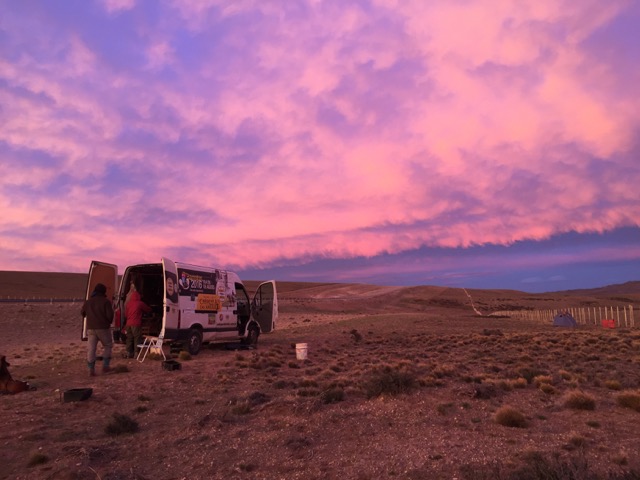Journey America Part 2
Back to the Desert 06.29.17

Before leaving Perito Moreno for the second time, with the support vehicle fixed also for the second time, I dropped Clara off at the bus station and said goodbye to my new friend.
“Thank you for inviting me Filipe,” she said before boarding her bus to El Bolson.
I went to the grocery store and with Butch Cassidy by my side, began the long drive to the ranch where Toti and the horses were resting. After organizing the van we hit the hay and awoke early the next morning to continue our journey.
Once again I suffered in the saddle. Powerful 120-km/h winds blowing days at a time. Desert nights in below-zero weather. Riding for 10 days straight without showering. I fought my way south — swaddled in longjohns, jeans, knee-high rubber boots, T-shirt, a button-up shirt, a hoodie, a windbreaker, a thick outback jacket, scarf, tuque, facemask, sunglasses, gloves topped by a black plastic rain poncho.
Some days, the wind was so strong, I was forced to lean forward and hug my horse’s neck, the wind making Sapo and Picasso stumble with every third stride. Even Toti suffered through the cold, stark terrain.
One hundred kilometres south of the small town of Governador Gregores, we were rescued from this neverending desert by a ranch called Estancia la Verde. We had passed many empty ranches so the thought of being with a real family lifted our spirits. Jorge Villalba, the manager of the ranch, invited us to a lamb barbecue and chance to hunt guanacos, the hardy llama of Argentina. Sitting down for dinner with this gracious gaucho and his lovely family, he explained why we were crossing hundreds of kilometres of ranchland without seeing a single family in the homes or animal in the pastures.
“Today these lands are plagued with government-protected guanacos, who overgraze the pastures. With the hard winters, finding people to work is nearly impossible. Most families picked up and left. It’s simply too difficult to ranch in Santa Cruz.”
One of the most important parts of Jorge’s job is tracking and killing pumas. These large grey felines prey on the more than 2,000 sheep on the ranch and they can kill up to 20 sheep in a night. Judging by the remarkable number of puma pelts in his barn, Jorge was an even match for the predator.
The next morning Jorge took us hunting! After he cleaned his rifle, we jumped into his silver pickup truck and drove through the ranch’s long pastures. He slammed on the brakes on a steep hill, turned off the truck and pointed the barrel of the rifle out the window. With a loud explosion, a guanaco about 50 metres to our left dropped to the ground. In a heartbeat we drove up to the wounded animal and, carefully grabbing its left ear, Jorge jabbed the sharp blade of his knife into the animal’s soft neck.
The animal twitched for a few seconds while it bled out. Jorge butchered the animal on the spot and we drove back to the ranch with the meat. As we packed up to move on Jorge handed us the dressed meat. “You guys take this for the road. With these cold temperatures you need to eat a lot of protein.”
From Estancia La Verde we continued trekking through this desolate, cold and windy province eating guanaco meat every day.
Twitter View All
@OrganikHipHop @TheSaurus831 @alexktwist @KingOfTheDot @RuinYourDayNow @NinoBless @GullyTK @regokotd This will be a banger 🔥
“Temos sérias preocupações de que o PL 2630 mude a internet que você conhece para pior e limite a inovação, a liberdade de expressão e a geração de oportunidades econômicas para todos os brasileiros.” Google Brasil #MaisDebatePL2630
RT @portolandia E, sem spoilers, o final deixa um gostinho de 'quero mais', esperando que as duas etapas seguintes — que ele já fez, indo do Alaska até Calgary e de Barretos até Ushuaia — também sejam registrados em todo seu esplendor. https://t.co/7BkLZ8dBxa pic.twitter.com/cx1fcXg5Xz